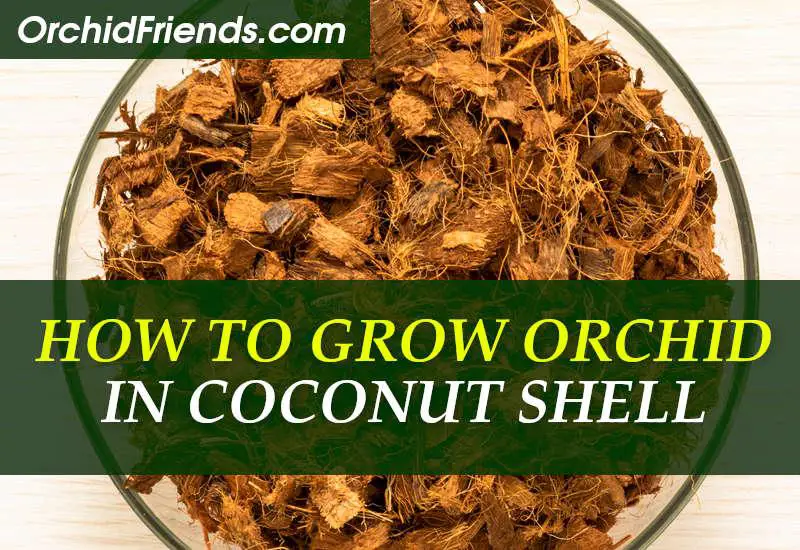
** This post is written and edited by a human being **
How to Grow Phalaenopsis Orchids in Coconut Shell
Growing Phalaenopsis orchids in coconut shell can be a unique and beautiful way to care for your plant. Coconut shells offer excellent drainage, a natural look, and an environment similar to the orchid’s native habitat. Let me guide you through how to properly grow and care for your Phalaenopsis orchids using coconut shells.
Why Coconut Shells?
Coconut shells are an excellent option for growing orchids because they are lightweight, durable, and provide good air circulation around the roots. They also help retain moisture without becoming too soggy, which is perfect for orchids like Phalaenopsis that prefer to dry out between waterings. Additionally, coconut shells are a sustainable, eco-friendly alternative to plastic pots.
How to Prepare the Coconut Shell
- Choose the Right Coconut Shell: You can use a whole coconut shell or a half-shell, depending on your preference. If using a whole coconut, carefully cut it in half. Make sure the shell is clean and has a good-sized opening to allow air circulation for the roots.
- Drainage Holes: Ensure the coconut shell has adequate drainage. Use a drill or a sharp object to create small holes in the bottom. Proper drainage is crucial to prevent water from collecting at the base, which could lead to root rot.
- Add a Layer of Sphagnum Moss: Before adding your orchid’s potting mix, place a layer of sphagnum moss at the bottom of the shell. This will help retain some moisture and prevent the mix from spilling out. You can also add a layer of small pebbles or charcoal for additional drainage if needed.
Choosing the Right Potting Mix
Phalaenopsis orchids thrive in well-draining mixes. In a coconut shell, it’s no different. I recommend using a bark-based orchid mix, which provides the right balance of aeration and moisture retention. You can also add perlite or charcoal.
Planting Your Phalaenopsis Orchid
- Prepare the Orchid: Carefully remove the Phalaenopsis orchid from its current pot, taking care not to damage the roots. Inspect the roots for any rot and trim away any unhealthy sections.
- Position the Orchid: Place the orchid into the coconut shell, ensuring the roots are spread out inside. Add the orchid mix around the roots, gently pressing it in place. Make sure the base of the plant is slightly above the lip of the shell to support the roots.
- Stabilize the Orchid: If necessary, use small stakes or plant ties to stabilize the orchid until the roots take hold in the new setup.
Caring for Your Phalaenopsis in Coconut Shell
- Watering: Coconut shells can dry out faster than traditional pots, so check the moisture level regularly. Water the orchid when the potting mix feels dry, but avoid letting the shell sit in water for too long. Phalaenopsis orchids like to dry out between waterings, so make sure the shell is draining properly.
- Humidity: These orchids thrive in humid environments, so placing a humidity tray under the coconut shell or using a room humidifier will help maintain the right moisture level around the plant. Keep the temperature between 65°F and 75°F (18°C to 24°C) for optimal growth. (This is, of course, not needed if your indoor air is not dry.)
- Light: Place the coconut shell in a location with bright, indirect light. Avoid direct sunlight, as it can scorch the leaves.
- Fertilizing: Feed your orchid with a balanced orchid fertilizer once a month during the growing season (spring and summer). Cut back on fertilizing during the winter when the plant is not actively growing.
- Repotting: Over time, the potting mix will break down, and the orchid may outgrow the shell. Typically, in ‘normal’ pots, Phalaenopsis orchids need repotting every 1-2 years. During repotting, check the roots and trim any damaged or dead ones.
Using Coconut Husk Chips
In addition to coconut shells, another excellent option for growing Phalaenopsis orchids is coconut husk chips. These chips are made from the fibrous material of the coconut husk and are known for their ability to retain moisture while also allowing for good air circulation. This makes them a great choice for orchids that need well-draining, yet moisture-retentive, growing mediums.
You can use coconut husk chips as part of your orchid mix, or even as the sole medium in your coconut shell pot. Here’s how:
- Prepare the Coconut Husk Chips: Soak the chips in water for a few hours before use. This helps them expand and retain moisture better once the orchid is planted.
- Use in the Shell: Once soaked, fill the bottom of your coconut shell with coconut husk chips, and then add your orchid’s roots, followed by more husk chips. This will create a well-draining environment that retains moisture without becoming too soggy, making it ideal for your Phalaenopsis orchid.
- Benefits of Coconut Husk Chips: Coconut husk chips have a natural resistance to breaking down, which means they will last longer than bark in providing aeration and moisture retention. They’re also a renewable, sustainable material that fits perfectly with the eco-friendly approach of using coconut shells.
Conclusion
Growing Phalaenopsis orchids in coconut shell pots offers a stylish and effective way to care for your plants. Whether you’re using coconut shells or coconut husk chips as part of the growing medium, these natural materials will help ensure that your orchid’s roots get the proper air circulation and moisture they need. With a little care and attention, your Phalaenopsis orchid will thrive in its coconut shell home, producing beautiful blooms year after year.
How to Grow Orchids on Wood Mounts
Growing Phalaenopsis orchids on wood mounts is a unique and natural way to display your plant while mimicking its native epiphytic growth in the wild. To mount your orchid, start by choosing a sturdy piece of wood, like cork bark or driftwood, that’s large enough to support the orchid’s roots. Secure the orchid to the wood using fishing line, soft wire, or plant ties, making sure the roots are spread out and in contact with the surface.
You can add a small amount of sphagnum moss around the roots to help retain moisture, but avoid over-mossing. Phalaenopsis orchids require high humidity, so placing the mounted orchid in a humid area or using a humidity tray will help keep the plant healthy. Water the orchid frequently, ensuring the roots don’t dry out completely, but be careful not to let it sit in water.
Wood mounting offers excellent air circulation and mimics the orchid’s natural environment, leading to vibrant growth and beautiful blooms. Just be prepared for more frequent care, as mounted orchids need regular watering and occasional misting to stay hydrated.
How to Grow Orchids in Charcoal
Using charcoal as the sole growing medium for Phalaenopsis orchids is an excellent option for those looking for excellent drainage and air circulation around the roots. Charcoal, particularly horticultural-grade charcoal, is lightweight, provides good moisture retention without becoming soggy, and helps prevent root rot by keeping the roots dry but hydrated. It also has natural antifungal properties, which can help protect your orchid from diseases.
Instructions for Growing Phalaenopsis Orchids in Charcoal
- Choose the Right Charcoal: Use high-quality, horticultural charcoal, which is specially designed for orchids. It should be chunkier, not the fine powdered type, to allow for proper airflow and drainage.
- Prepare the Pot: Select a pot with drainage holes to ensure that excess water can escape. Fill the pot about halfway with charcoal.
- Place the Orchid: Gently remove your Phalaenopsis orchid from its current pot and inspect the roots for any damage. Place the orchid in the pot and position it so the roots are spread out evenly in the charcoal.
- Add Charcoal Around the Roots: Fill the rest of the pot with charcoal, ensuring that the roots are completely surrounded and supported. Leave the base of the plant slightly above the lip of the pot, so it is stable but not buried too deep.
- Watering and Maintenance: Water your orchid thoroughly, but allow the charcoal to dry out a little between waterings. Charcoal dries out faster than bark, so monitor the moisture levels carefully. Keep the orchid in a bright, indirect light location and maintain a humid environment to support the plant’s growth.
- Repotting: Since charcoal breaks down slowly, you can keep your orchid in the charcoal mix for up to 2 years before needing to repot. Over time, you may need to replace the charcoal as it becomes more compacted or breaks down.



